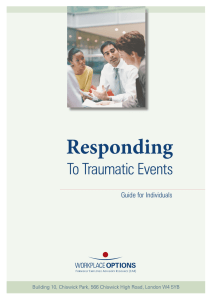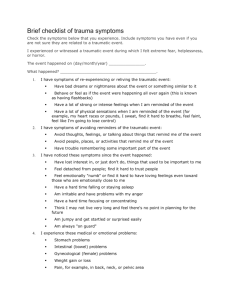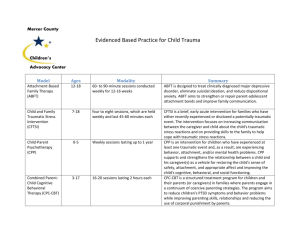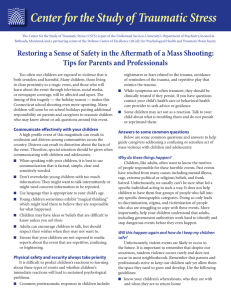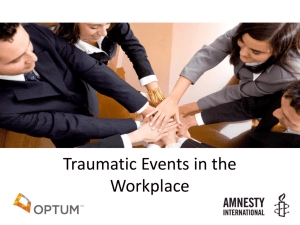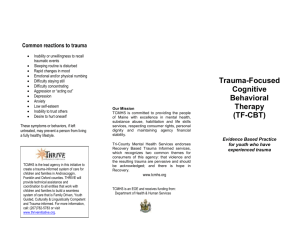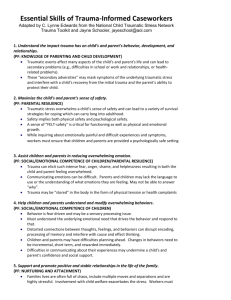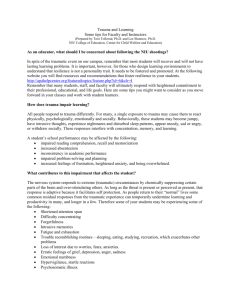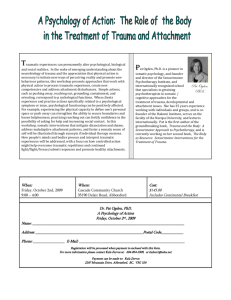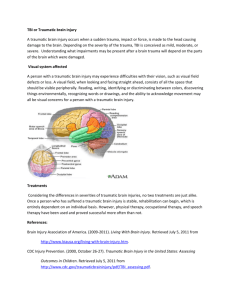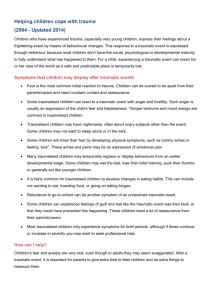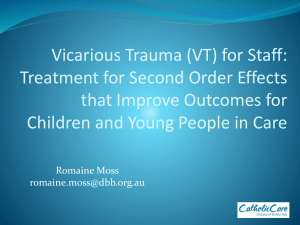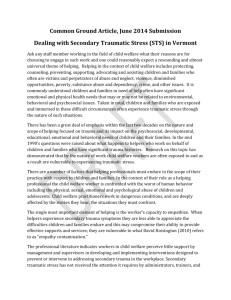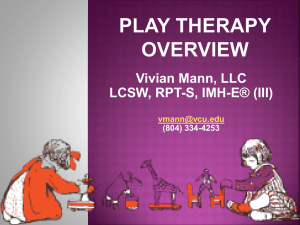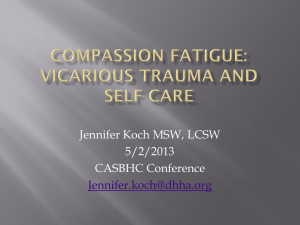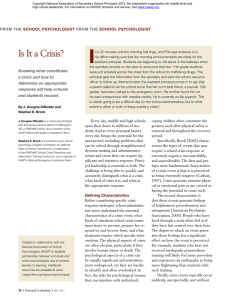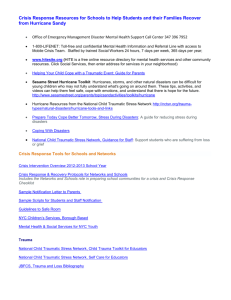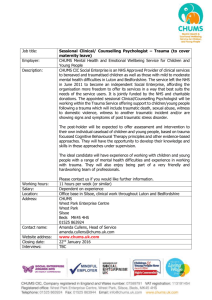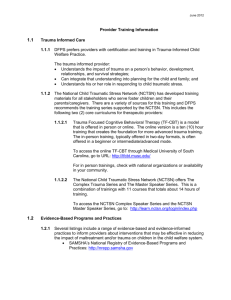Dealing with Crisis and Traumatic Events (WORD)
advertisement
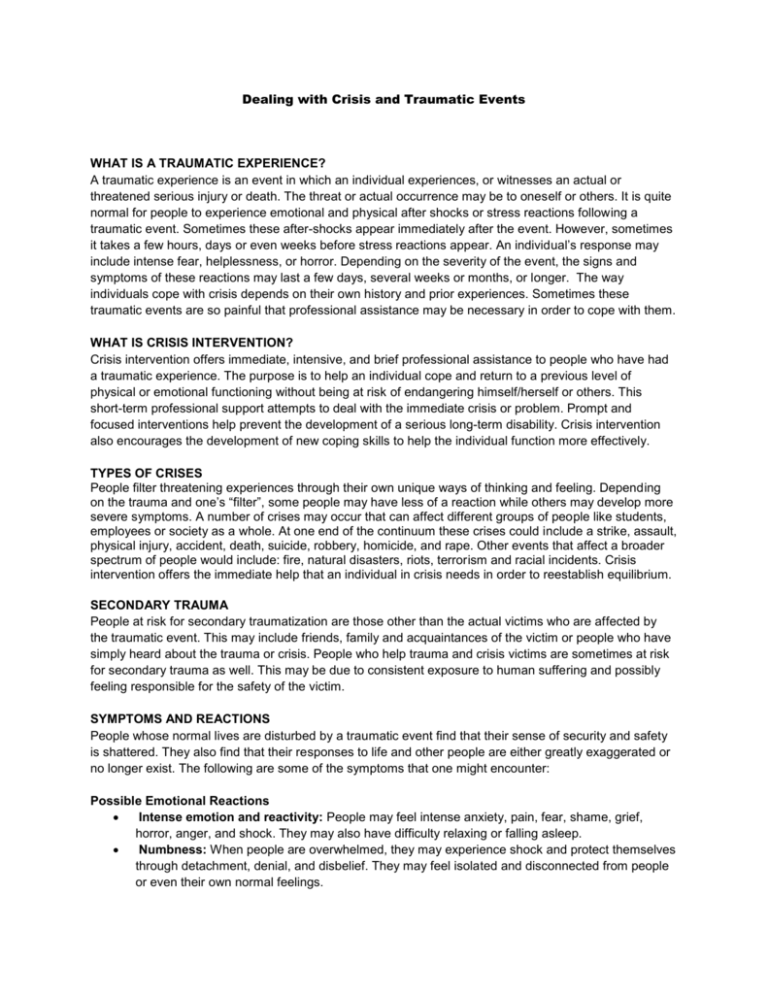
Dealing with Crisis and Traumatic Events WHAT IS A TRAUMATIC EXPERIENCE? A traumatic experience is an event in which an individual experiences, or witnesses an actual or threatened serious injury or death. The threat or actual occurrence may be to oneself or others. It is quite normal for people to experience emotional and physical after shocks or stress reactions following a traumatic event. Sometimes these after-shocks appear immediately after the event. However, sometimes it takes a few hours, days or even weeks before stress reactions appear. An individual’s response may include intense fear, helplessness, or horror. Depending on the severity of the event, the signs and symptoms of these reactions may last a few days, several weeks or months, or longer. The way individuals cope with crisis depends on their own history and prior experiences. Sometimes these traumatic events are so painful that professional assistance may be necessary in order to cope with them. WHAT IS CRISIS INTERVENTION? Crisis intervention offers immediate, intensive, and brief professional assistance to people who have had a traumatic experience. The purpose is to help an individual cope and return to a previous level of physical or emotional functioning without being at risk of endangering himself/herself or others. This short-term professional support attempts to deal with the immediate crisis or problem. Prompt and focused interventions help prevent the development of a serious long-term disability. Crisis intervention also encourages the development of new coping skills to help the individual function more effectively. TYPES OF CRISES People filter threatening experiences through their own unique ways of thinking and feeling. Depending on the trauma and one’s “filter”, some people may have less of a reaction while others may develop more severe symptoms. A number of crises may occur that can affect different groups of people like students, employees or society as a whole. At one end of the continuum these crises could include a strike, assault, physical injury, accident, death, suicide, robbery, homicide, and rape. Other events that affect a broader spectrum of people would include: fire, natural disasters, riots, terrorism and racial incidents. Crisis intervention offers the immediate help that an individual in crisis needs in order to reestablish equilibrium. SECONDARY TRAUMA People at risk for secondary traumatization are those other than the actual victims who are affected by the traumatic event. This may include friends, family and acquaintances of the victim or people who have simply heard about the trauma or crisis. People who help trauma and crisis victims are sometimes at risk for secondary trauma as well. This may be due to consistent exposure to human suffering and possibly feeling responsible for the safety of the victim. SYMPTOMS AND REACTIONS People whose normal lives are disturbed by a traumatic event find that their sense of security and safety is shattered. They also find that their responses to life and other people are either greatly exaggerated or no longer exist. The following are some of the symptoms that one might encounter: Possible Emotional Reactions Intense emotion and reactivity: People may feel intense anxiety, pain, fear, shame, grief, horror, anger, and shock. They may also have difficulty relaxing or falling asleep. Numbness: When people are overwhelmed, they may experience shock and protect themselves through detachment, denial, and disbelief. They may feel isolated and disconnected from people or even their own normal feelings. Depression: People may have difficulty concentrating or remembering. They may also experience diminished interest in everyday activities and have crying spells. A sense of despair and hopelessness may be very evident. Flashbacks: People often re-experience the traumatic event over and over again. The feeling of not having any control is heightened. They may feel tortured by the invading thoughts and memories. Nightmares: These are like flashbacks but they occur in dreams. As a result, people may have difficulty sleeping. Re-experiencing the trauma intensifies feelings of panic and helplessness. Triggering events and people: Often, people will attempt to avoid anything associated with the trauma. However, events that remind them of the trauma may trigger feelings initially triggered by the trauma itself. Possible Physical Reactions Aches and pains such as headaches, and backaches, etc. Weakness, dizziness, and fatigue most of the time. Heart palpitations, profuse sweating and chills. Changes in sleep patterns. Changes in appetite and digestive problems. Being easily startled by noises and/or unexpected touch. Increased susceptibility to allergies, colds and illnesses. Increased alcohol consumption and/or substance abuse. How to Better Cope Recognize your own feelings. Also understand that your feelings are a normal reaction to an abnormal situation. Talk about the experience. Talk is healing. Reach out to friends and family for support. Try to connect with others, especially those who may have shared the same stressful experience. Form a support group. Set small realistic goals to help tackle obstacles. Take one day at a time and be kind to yourself. Get as much physical activity as possible. Exercise or learn relaxation techniques or meditation in order to relax and feel rejuvenated. Structure your time. Schedule breaks for yourself. Redefine your priorities and focus your energy on them. Get involved in something that is personally meaningful and important everyday. Give yourself time to heal. Give someone a hug—touching is very important.
